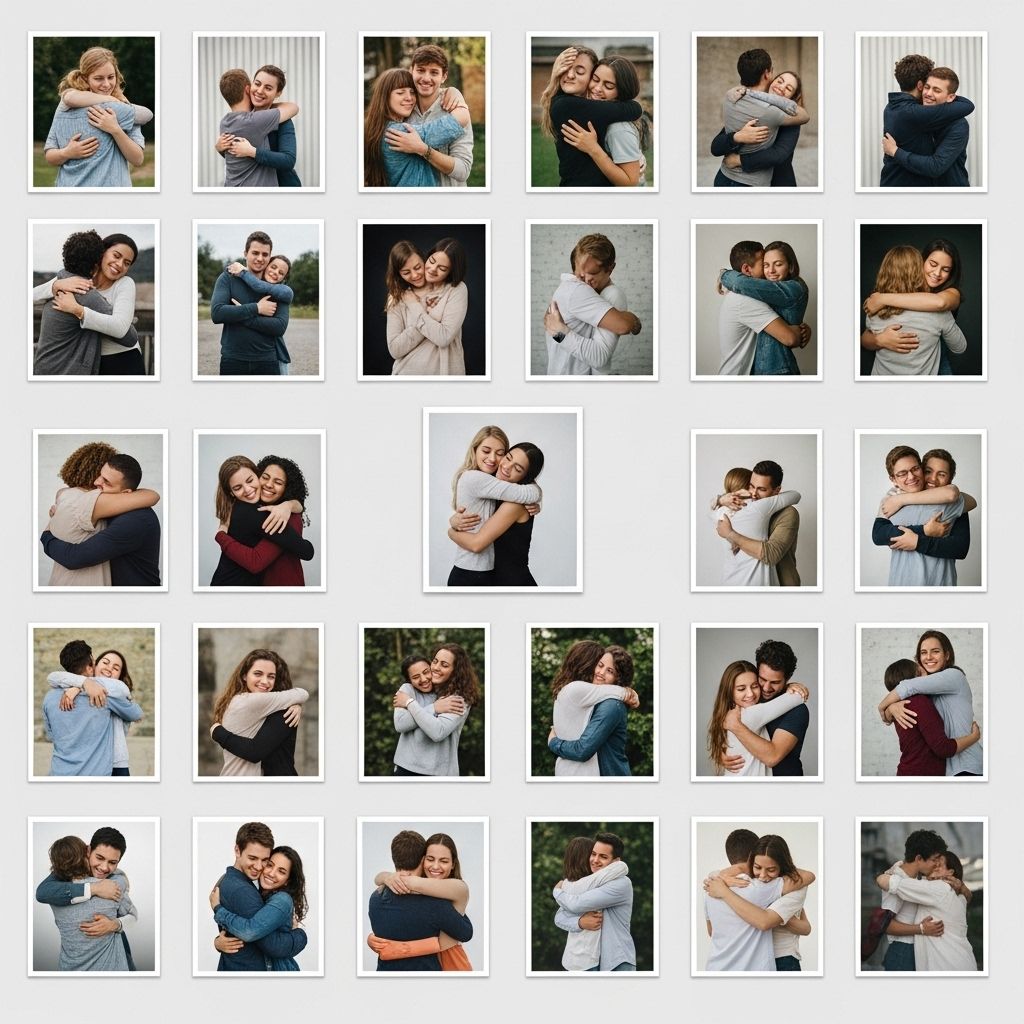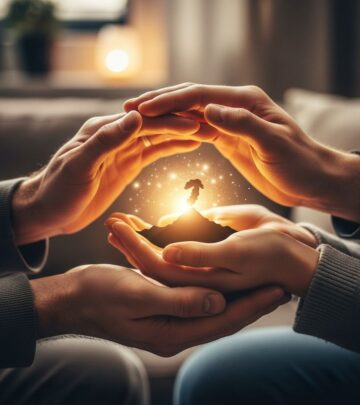29 Types of Hugs: Meanings and Relationship Insights
From bear hugs to side hugs, decode the subtle signals behind 29 common types of hugs and discover their emotional roots.

Understanding the Language of Hugs: Types, Meanings, and Insights
Hugs are a universal form of touch, offering comfort, warmth, and a wordless way to connect. The way someone hugs can reveal layers of emotional nuances, intentions, and the bond between two people. From a tight embrace signifying deep emotional connection, to a quick side hug hinting at formality or caution, each hug conveys its own story. In this comprehensive guide, explore 29 different types of hugs, what each means, and how these gestures shape our relationships.
Why Hugs Are Important
Hugs play a crucial role in human relationships. They:
- Express love, affection, and empathy without words
- Provide comfort in times of distress
- Reinforce social bonds and trust
- Help alleviate stress by releasing oxytocin (the ‘cuddle hormone’)
- Bridge emotional gaps or celebrate shared happiness
Relationship counselors note that the type of hug—its closeness, intensity, and context—offers clues to a person’s emotional state and relational dynamics.
29 Different Types of Hugs and Their Meanings
1. The Bear Hug
Arguably the most genuine and heartfelt hug, the bear hug involves wrapping your arms tightly around someone’s body. It is usually platonic, filled with warmth, and offers reassurance, protection, and relief from anxiety. Often shared in moments of excitement, joy, or profound emotion, this embrace conveys a deep caring bond.
2. The Tight Hug
In this full-bodied, warm embrace, both people completely wrap their arms around each other. It’s reserved for those you share a strong emotional connection with. Often, a tight hug is offered during intense emotional moments—meeting after a long absence, saying goodbye, or offering silent comfort during difficult times.
3. The Back Hug
Also called a hug from behind, this gesture is a surprise embrace where one person wraps their arms around the other from behind. It signals trust, intimacy, and a strong emotional bond. Often, a gentle backstroke or soft nuzzle accompanies this hug, amplifying feelings words cannot describe.
4. The Side Hug
The side hug, or one-armed hug, is less intimate and often shared among friends, colleagues, or acquaintances. While more relaxed and casual—commonly seen in group photos or workplace settings—it can still be supportive and sincere, especially among long-term friends or at social gatherings.
5. The Friend Hug
This type is ideal for close friends or acquaintances but not for your best buddy. Typically, one arm goes over the other’s shoulder and the other under their armpit, often resulting in a loose yet approval-filled embrace. It’s a way to non-verbally say “I like spending time with you!” without romantic intent.
6. The One-Armed Hug
This hug involves wrapping a single arm around another person’s back, without much body contact. It’s friendly and platonic, often indicating the person sees you as an acquaintance or casual friend. While not highly intimate, it still communicates comfort and rapport.
7. The Resting-Heads-on-Each-Other Hug
Partners or close companions sometimes rest their heads on each other while hugging. This intimate gesture is a cozy, long-lasting cuddle, signaling deep trust, comfort, and enduring romantic feelings.
8. The Twirling-You-Around Hug
A playful, joyous embrace where a taller person lifts and spins their partner or friend. Seen during emotional reunions at airports or special occasions, this hug radiates happiness and reflects a strong connection.
9. The Sloppy Hug
Often exchanged at parties or social gatherings to appear warm and sociable, the sloppy hug is informal and may last longer than necessary, but usually lacks deep meaning. More about courtesy than true connection, it is common among friends of different genders or new acquaintances.
10. The Triangle Hug
When two people feel a bit awkward but are compelled to hug, their lower bodies remain apart, forming a triangle shape. This hug usually represents hesitation, obligation, or uncertainty about the closeness in the relationship.
11. The Waist Hug
When both individuals wrap their arms around each other’s waist and look into each other’s eyes, it’s a romantic, inviting gesture. It often leads to greater intimacy, signaling a willingness to be vulnerable and emotionally open.
12. The Catcher Hug
This exuberant hug is seen in romantic films—one person jumps into the other’s arms, both wrapping their arms around the other, sometimes even lifting off the ground. It reveals sheer happiness, excitement, and deep affection, often after long separations.
13. The London Bridge Hug
A formal, almost awkward embrace, usually characterized by significant physical distance between the two people—heads and shoulders touch, but lower bodies are far apart. This professional or polite hug implies boundaries or discomfort with closeness.
14. The Hug with a Pat
A pat on the back during a hug, often among friends or family, adds an element of reassurance, cheer, or consolation. While less passionate, it provides a sense of camaraderie and comfort.
15. The Quick Hug
An express-hug, often exchanged in public or busy settings. It’s brief and functional, yet can be very heartfelt—expressing care, gratitude, or encouragement without lingering.
16. The Polite Hug
Common in professional or formal settings, the polite hug is a quick, light squeeze with barely any body contact. It signifies respect or acknowledgment without deeper emotional engagement.
17. The Leaning Hug
This hug is shared while reclining, where two people lean into each other for support and connection. Usually heartfelt, it suggests a desire for comfort, rest, and mutual reassurance.
18. The Face-to-Face Hug
Both people stand close to each other, arms around the shoulders, making direct eye contact. This hug exudes warmth, trust, and the feeling of being on the same page emotionally.
19. The Long Hug
Lasting well beyond a typical embrace, a long hug usually suggests a need for extra comfort and understanding, especially during times of crisis, sorrow, or emotional intensity. It allows both people to literally and figuratively hold each other up.
20. The Heart-to-Heart Hug
Both participants embrace in such a way that their hearts are aligned, symbolizing vulnerability, honesty, and deep affection. This is particularly common among couples and close loved ones.
21. The Pick-Me-Up Hug
One person lifts the other off their feet during a warm hug. It’s a joyful, spontaneous display of happiness and can be romantic or platonic, depending on context.
22. The Squeeze Hug
A tighter, more forceful hug than usual—sometimes intended to show overwhelming happiness, gratitude, or emotional intensity.
23. The Dancing Hug
Both people stand close together, arms encircling each other’s bodies, swaying gently as they enjoy the moment. Although playful, the dancing hug can also be deeply romantic or celebratory.
24. The Cheek-to-Cheek Hug
This gentle hug involves pressing cheeks together and wrapping arms around each other, often seen between close friends or family, and is usually accompanied by a whispered message or quiet comfort.
25. The Resting-Heads-On-Each-Other Hug (Romantic Variation)
Cuddling close, partners rest their heads on each other, signifying mutual trust, deep comfort, and love. It is a favorite among long-term couples, reflecting security and affection.
26. The Twirling-You-Around Hug (Reunion Variation)
Similar to the previous twirling hug, but specifically marking reunions after long periods apart. This exuberant motion combines excitement, emotion, and joy in a single movement.
27. The Sloppy Hug (Party Variation)
At lively gatherings, a loose, drawn-out embrace may be exchanged simply to build rapport or maintain social connections—generally warm and friendly, but not especially personal.
28. The Triangle Hug (Awkward Variation)
This hug occurs when people feel obliged but uncomfortable about the closeness, often at family functions or formal events, maintaining a polite distance while acknowledging the situation.
29. The One-Armed Hug (Casual Variation)
Wrap a single arm around someone in a brief, friendly hug—appropriate for acquaintances or in low-stakes social settings. This gesture communicates comfort and approachability without crossing boundaries.
Table: Common Types of Hugs and Their Emotional Meaning
| Hug Type | Typical Emotional Meaning | Common Context |
|---|---|---|
| Bear Hug | Warmth, protection, deep care | Friends, family, reunions |
| Back Hug | Trust, intimacy, affection | Partners, close friends |
| Side Hug | Friendship, encouragement, support | Friends, work, casual |
| One-Armed Hug | Camaraderie, comfort | Acquaintances, casual contacts |
| Waist Hug | Romantic attraction, vulnerability | Couples, budding romance |
| Hug with a Pat | Support, consolation | Friends, family |
| Polite Hug | Respect, acknowledgment | Formal events, professional |
Intentions and Relationship Messages in Hugs
Hugs aren’t all about affection—they also communicate boundaries, intentions, and emotional needs. A tighter, longer hug suggests a longing for closeness or support, whereas a brief or distant hug could signal discomfort or the need for boundaries. Factors that influence hug meaning include:
- Relationship type (romantic, friend, family, acquaintance)
- Context and timing (hello, goodbye, celebration, comfort after loss)
- Duration and intensity (quick vs. lingering, gentle vs. firm)
Always consider body language as a whole rather than just the hug itself.
Tips for Navigating Hug Etiquette
- Observe the other person’s body language before initiating a hug.
- Respect personal and cultural boundaries—some people or cultures may prefer less physical contact.
- When in doubt, ask or wait for an invitation, especially in professional or new relationships.
- Keep hugs brief and non-intrusive in formal settings.
- Use hugging as a tool for comfort, connection, and celebration, but never to impose.
Hug Types and Cultural Variations
While hugs are common in many cultures, their meaning and appropriateness can vary. In some societies, hugging is reserved for family and close friends; in others, it is a standard greeting. Always be mindful of context and cultural norms before offering a hug.
Benefits of Hugging
The emotional importance of hugs is backed by science:
- Release of oxytocin (the bonding hormone), promoting feelings of wellbeing and trust
- Reduction in stress with lower cortisol levels
- Strengthening of immune function
- Increased sense of belonging and happiness
Hugs are much more than simple gestures—they’re essential to our emotional and physical health.
Frequently Asked Questions (FAQs)
Q: Can a hug really indicate someone’s feelings?
A: Yes, the nature of a hug—its duration, intensity, and closeness—can provide clear clues about someone’s emotional state and comfort level. A bear hug or long embrace, for example, often reflects a strong desire for connection and reassurance.
Q: Is there such a thing as a “bad” hug?
A: A hug that feels forced, cold, or overly brief may signal discomfort, uncertainty, or boundaries being tested. Respect both your own and others’ boundaries for the most positive experience.
Q: How do I know if a hug is platonic or romantic?
A: Look at factors like body contact, duration, and context. Romantic hugs are often longer, closer, and might involve head resting or waist embraces, while platonic hugs are looser and less prolonged.
Q: Do all cultures view hugging the same way?
A: No, while hugs are nearly universal, cultural expectations and appropriateness vary. In some cultures, hugs are only for family; in others, they are part of everyday greetings.
Q: Can hugging improve my mood?
A: Yes. Hugs stimulate oxytocin release, often called the “cuddle hormone,” which can reduce stress, lower anxiety, and foster happiness.
References
Read full bio of Sneha Tete












